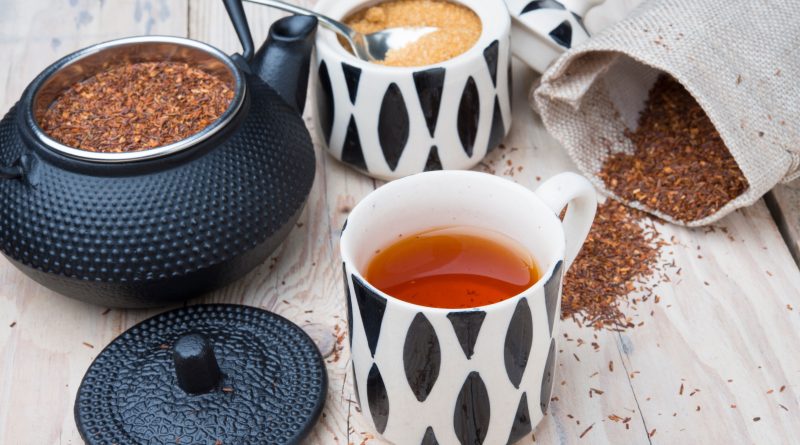Using Rooibos Tea as a Blackwater Extract
No idea when or where this started, but for the last decade or so there has been this idea that you can just add a cup of Rooibos tea to your blackwater set up and hey presto you have the correct profile of tannins to give your fish everything they need. For a quick TL:DR don’t add Rooibos tea to your aquarium.
What is Rooibos tea?
Rooibos come from a shrub native to South Africa, Aspalathus linearis. Rooibos is picked as green leaves, so young fresh leaves, this is important. They are then fermented, the red rooibos tea we tend to think of is fermented for longer than the green version. Famed for it’s antioxidants, being caffeine free, and low or no tannin levels. But that’s not all it contains.
Aspalathus linearis contain hydroxylated benzoic and cinnamic acids, luteolin, chrysoeriol, quercetin, isoquercitrin, the C–C linked β-d-glucopyranosides based on four flavones and the dihydrochalcone aspalathin (Rabe et al., 1994). Some of these flavonoids are will improve the growth of certain fish including some species of channa showing improved growth when fed isoquercitrin (Kong et al., 2022). But there are a lot more than just that one compound, and fermentation, storage, and finally boiling will alter and degrade some of these compounds. Aspalathin is some what unique to Rooibos as far as we know and if famed for lowing blood glucose. Fantastic if you’re a prediabetic human who’s just had a donut with a cup of tea. Less ideal if your a tetra swimming in the stuff.
Honestly we have no idea what most of those compounds will do to fish. Maybe nothing, but that’s not the natural chemical profile of a blackwater stream.
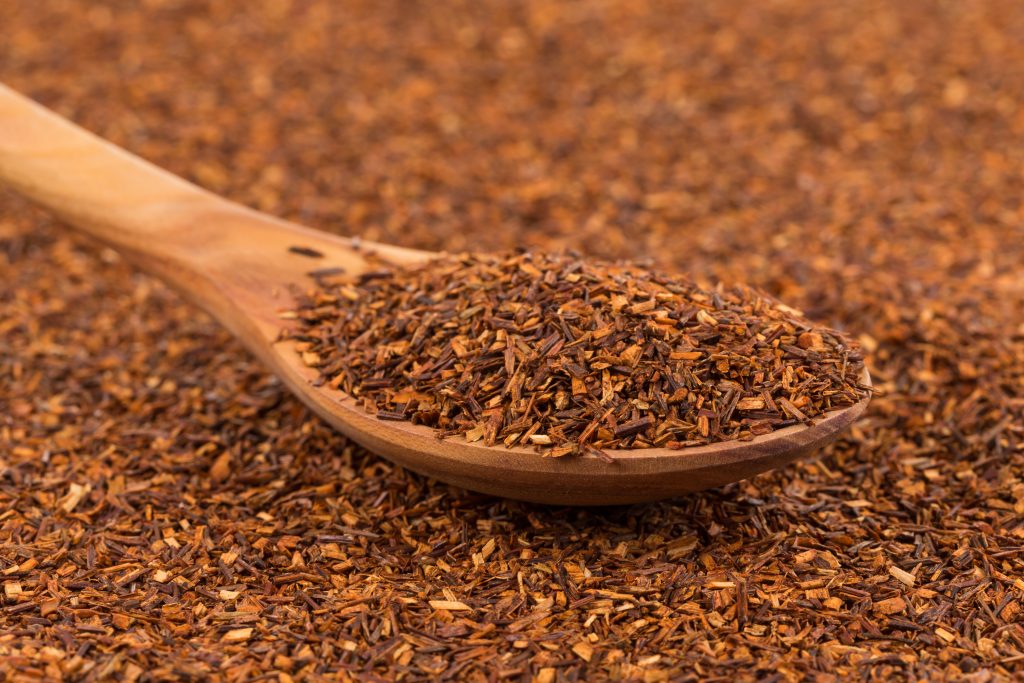
Are all Rooibos teas the same?
No, some have twice the catechin content of the other. In one study the teas were prepared and the pH varied wildly between brands, some as low as 5.2 others 6.4 that means some will be 10 to 20 times more acidic than others.
Added to that many have pesticide residue on the leaves (O.M. Areo et al., 2022). That can vary from brand to brand. Again safe for a large human to drink, but not necessarily for a small fish to swim in.
Are there any tannins in Rooibos?
Here comes the next issue. Catechins used to be grouped into tannins, but not any longer. So Rooibos contains catechins, but not tannins. Why this is an issue is that the things in rivers we may refer to as tannins may also contain catechins as a part of the whole. We don’t know which types of tannins, or even Catechins give the benefits that we are looking for.
So rooibos contains 400-800 mg catechins per 100g of leaves in a litre of water. A tea bag is normally between 1 and 2 g of leaves, giving you between 4 and 16 mg of catechins per tea bag.
Compare that to oak leaves in September, that contain tannins of various types, and catechins. The total weight of those is about 5% of the dry weight of the leaves (Feeny, 1968), so to get 10mg of tannins from dried autumn Oak leaves you need about 200mg of dried oak leaves. Decent Rooibos isn’t cheap, Oak leaves are if you collect them at the right time of the year.
What are tannins?
Tannins are found in most plants to varying degrees. For the plants they provide a method of defence, both by making the plant taste bitter and unpalatable to potential browsing animals, and reducing the pathogens that might infect the plant. They are a wonder of nature helping reduce bacteria, fungi, viruses, and more. But they’re not the cure all that you might read on some forums.
Tannins are named for their role in the tanning industry. Or tanning is named that because of tannins, it’s unclear. But if you submerge an animal hide in a liquid containing a lot of tannins, it turns the hide into leather. One of the main reasons for this is the tannins bind to the proteins in the hide.
This is great to make leather. But it’s this binding to proteins and various minerals that make tannins an issue in higher concentrations. Not only will they bind to the molecules in the diet, but also to the molecules in the fish themselves, damaging gills and other organs.
Tannins can be grouped into condensed and hydrolysable tannins. Condensed tannins are complex and large molecules They are not properly absorbed into the blood. It seems that the adverse effects are probably due to tannic acid, which is hydrolysable (Mandal and Ghosh, 2009)
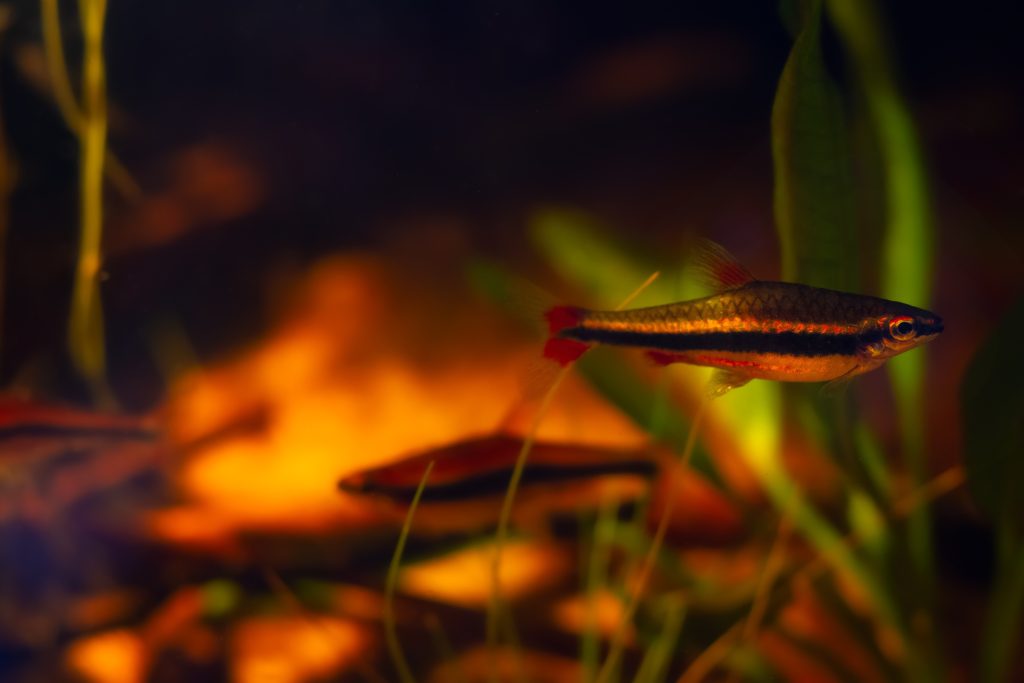
Are tannins safe for all fish?
No, for a variety of reasons, the tannase that some fish can use to breaks down tannins in their gut are in some cases produced by other things in their guts, such as types of yeast. Now it’s not clear where the those yeasts etc. come from. Are they naturally found in the same environments that the tannins are? Do they absorb them from their natural environment in the wild? Are they passed around in the shoal, school or other family group? Honestly we don’t have answers for this sort of thing yet.
To make things a bit more complex there are different types of tannase, that deal with different types of tannins (Ristinmaa et al., 2022) These tannase producing bacteria may also be present in the soil and change the tannic profile in the water itself. But there aren’t the studies on fish to show what they have and how that might differ in the various waters around the globe.
There is a general rule of thumb that soft water fish will have tannase to break down the tannins, and hard water fish won’t. But any plants in the fishes wild diet might contain tannins. But small amounts might not require tannase for the fish to survive. The tannins might bing to some of the proteins, but if there is enough in the diet over and above that amount they will be fine. However if you then put a hardwater fish with no adaptations to tannins into a tannin rich aquarium they probably will struggle and potentially die.
We know from some mammals that there is a trade off in terms of tannins. For some livestock tannins can inhibit growth if fed in too large an amount, or even cause death, but can provide protection from bloat and a variety of diseases in smaller amounts. As with many of the micronutrients in any diet it seems that a small amount is vital, a medium amount ideal, a large amount an issue, and a huge amount fatal. The amounts are the issue. Something that has evolved in, and grow in a blackwater stream in the wild will cope with, and the evidence from breeding these species seems to show need, much higher levels of tannins than a fish that has evolved in water with few if any tannins. Only having small amounts in a diet that is low in tannins.
What tannins are in black water streams and ponds?
That’s a hard question to answer, especially as the tree assembled, and so the tannin profiles, can differ from stream to stream, never mind from continent to continent. There are some generalisations that can be made, but they’re just that.
Looking at just the variations in condensing tannins (CT) and hydrolysing tannins (HT). Over the growing season CTs seem to accumulate in some plants whilsts HTs reduce. Meaning that when the bulk of the leaves drop, or older plants die at the end of the season the CTs will be higher and the HTs lower. Seeds and berries will have varying amounts of different types of tannins. In the wild those with the higher HTs may taste better and so are more likely to be eaten and then digested before the tannins are in the soil and then water. But again there are so many variables to take into account.
To give you a quick idea of how much of a headache this is a study in 1993 (Picker, McKenzie and Fielding, 1993) examined the biochemicals in the water of a blackwater stream, and found low levels of tannins, and high dissolved oxygen. But as far as we know the dark colouration of the black water streams comes from tannins?
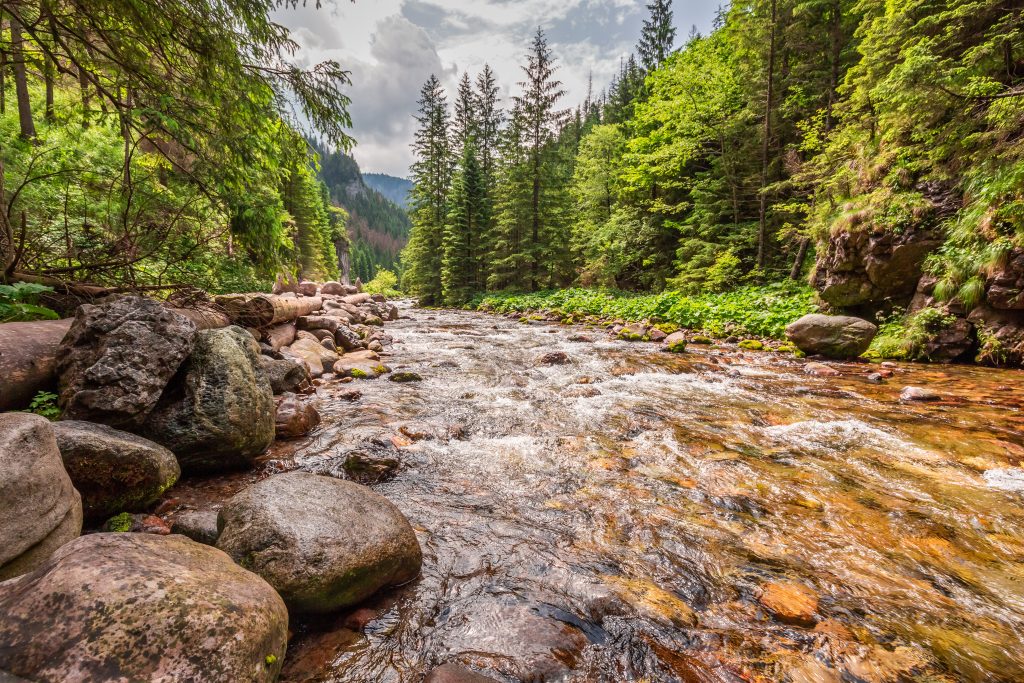
Adding tannins to your tanks
Add botanicals, and add the botanicals that are native to the region your fish come from, or as close as is sensibly possible. Add a wide variety so that if there are any that wouldn’t dominate in the tropical jungle, or other biotope, your fish come from they will only be a part of the whole.
Personally I wouldn’t boil my botanicals. Some tannins and other compounds break down when exposed to heat, and the compounds they for can be less than ideal.
I wouldn’t add any form of herbal teas to my tank, and that includes Rooibos, largely the tannins from the forests are coming from leaves, bark, branches, roots etc. come from material later in the growing cycle. Meaning a different tannin profile to the fresh live leave picked for a drink.
If we want to mimic nature, we need to mimic nature, not try and take shortcuts that give you a visual, but not a chemical match.
As with all aspects of fish keeping research and patience is the key, maybe with a nice cup of tea?
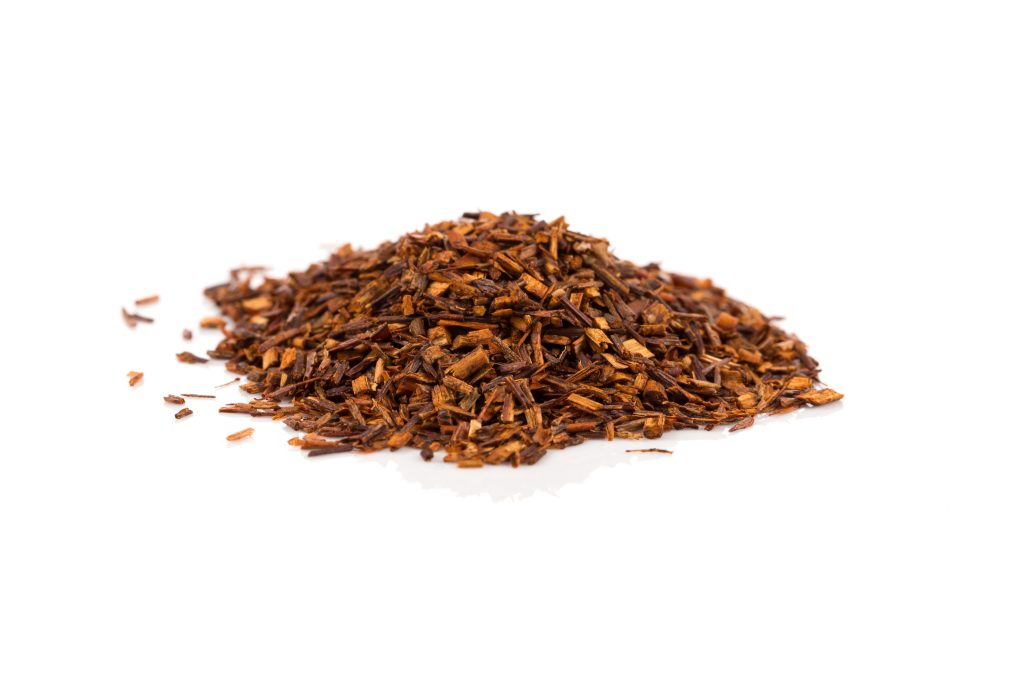
Some of the stuff I read whilst researching this
Bramati, Lorenzo, et al. “Quantitative Characterization of Flavonoid Compounds in Rooibos Tea (Aspalathus Linearis) by LC−UV/DAD.” Journal of Agricultural and Food Chemistry, vol. 50, no. 20, 30 Aug. 2002, pp. 5513–5519, ui.adsabs.harvard.edu/abs/2002JAFC…50.5513B/abstract, https://doi.org/10.1021/jf025697h. Accessed 17 May 2025.
C. Peter Constabel, et al. Diverse Ecological Roles of Plant Tannins: Plant Defense and Beyond. 11 Aug. 2014, pp. 115–142, www.researchgate.net/publication/269277107_Diverse_Ecological_Roles_of_Plant_Tannins_Plant_Defense_and_Beyond, https://doi.org/10.1002/9781118329634.ch5. Accessed 17 May 2025.
Denisa Neamtiu, and Simona Oancea. “Evaluation of the Content of Polyphenolic-Based Antioxidant Compounds of Different Flavored And…” ResearchGate, vol. 22, no. 3, 13 Feb. 2018, pp. 99–104, www.researchgate.net/publication/323143621_Evaluation_of_the_content_of_polyphenolic-based_antioxidant_compounds_of_different_flavored_and_non-flavored_Rooibos_Aspalathus_linearis_infusions, https://doi.org/10.15192/PSCP.ASR.2018.22.3.99104. Accessed 17 May 2025.
Earl, Julia E, et al. “Effects of Soil, Light, and Temperature on Freshwater Tannin Concentrations.” Hydrobiology, vol. 4, no. 1, 10 Jan. 2025, pp. 2–2, www.mdpi.com/2673-9917/4/1/2, https://doi.org/10.3390/hydrobiology4010002. Accessed 19 May 2025.
Feeny, P. “Seasonal Changes in the Tannin Content of Oak Leaves.” Phytochemistry, vol. 7, no. 5, 1 May 1968, pp. 871–880, www.sciencedirect.com/science/article/abs/pii/S0031942200848451, https://doi.org/10.1016/s0031-9422(00)84845-1. Accessed 19 May 2025.
Flotemersch, Joseph E., et al. “Distribution and Characteristics of Blackwater Rivers and Streams of the Contiguous United States.” Water Resources Research, vol. 60, no. 2, Feb. 2024, agupubs.onlinelibrary.wiley.com/doi/full/10.1029/2023WR035529, https://doi.org/10.1029/2023wr035529. Accessed 19 May 2025.
Hoque, Farhana, et al. Gut Microbiome and Fish Health: An Overview in Finfish Aquaculture Prospective. 1 Jan. 2023, pp. 47–74, link.springer.com/chapter/10.1007/978-981-99-0852-3_3, https://doi.org/10.1007/978-981-99-0852-3_3. Accessed 19 May 2025.
Irvine, Kim, et al. “The “Black Waters” of Malaysia: Tracking Water Quality from the Peat Swamp Forest to the Sea.” 2012 International Symposium on Geomatics for Integrated Water Resource Management, Oct. 2012, pp. 1–6, ieeexplore.ieee.org/abstract/document/6349584, https://doi.org/10.1109/giwrm.2012.6349584. Accessed 19 May 2025.
Iswaldi, Ihsan, et al. “Identification of Phenolic Compounds in Aqueous and Ethanolic Rooibos Extracts (Aspalathus Linearis) by HPLC-ESI-MS (TOF/IT).” Analytical and Bioanalytical Chemistry, vol. 400, no. 10, 21 Apr. 2011, pp. 3643–3654, link.springer.com/article/10.1007/s00216-011-4998-z, https://doi.org/10.1007/s00216-011-4998-z. Accessed 17 May 2025.
Kong, Yuxin, et al. “Effects of Dietary Quercetin on Growth, Antioxidant Capacity, Immune Response and Immune-Related Gene Expression in Snakehead Fish, Channa Argus.” Aquaculture Reports, vol. 26, 5 Sept. 2022, pp. 101314–101314, www.sciencedirect.com/science/article/pii/S2352513422003106, https://doi.org/10.1016/j.aqrep.2022.101314. Accessed 17 May 2025.
Li, Mei, et al. “Condensed Tannins Decreased the Growth Performance and Impaired Intestinal Immune Function in On-Growing Grass Carp (Ctenopharyngodon Idella).” British Journal of Nutrition, vol. 123, no. 7, 13 Dec. 2019, pp. 737–755, www.cambridge.org/core/journals/british-journal-of-nutrition/article/condensed-tannins-decreased-the-growth-performance-and-impaired-intestinal-immune-function-in-ongrowing-grass-carp-ctenopharyngodon-idella/5007B39BFC371DAD2758E9BACB987ACD#, https://doi.org/10.1017/s0007114519003295. Accessed 17 May 2025.
Mandal, S, and K Ghosh. “Isolation of Tannase-Producing Microbiota from the Gastrointestinal Tracts of Some Freshwater Fish.” Journal of Applied Ichthyology, vol. 29, no. 1, 18 Sept. 2012, pp. 145–153, onlinelibrary.wiley.com/doi/abs/10.1111/j.1439-0426.2012.02054.x, https://doi.org/10.1111/j.1439-0426.2012.02054.x. Accessed 17 May 2025.
Mandal, Sudipta, and Koushik Ghosh. “Accumulation of Tannin in Different Tissues of Indian Major Carps and Exotic Carps.” Aquaculture Research, vol. 41, no. 6, 19 Aug. 2009, pp. 945–948, onlinelibrary.wiley.com/doi/10.1111/j.1365-2109.2009.02371.x, https://doi.org/10.1111/j.1365-2109.2009.02371.x. Accessed 17 May 2025.
Mazibuko-Mbeje, Sithandiwe E, et al. “Aspalathin, a Natural Product with the Potential to Reverse Hepatic Insulin Resistance by Improving Energy Metabolism and Mitochondrial Respiration.” PLoS ONE, vol. 14, no. 5, 2 May 2019, pp. e0216172–e0216172, pmc.ncbi.nlm.nih.gov/articles/PMC6497260/, https://doi.org/10.1371/journal.pone.0216172. Accessed 19 May 2025.
O.M. Areo, et al. “Determination of Pesticide Residues in Rooibos (Aspalathus Linearis) Teas in South Africa.” Toxicology Reports, vol. 9, 1 Jan. 2022, pp. 852–857, www.sciencedirect.com/science/article/pii/S221475002200083X, https://doi.org/10.1016/j.toxrep.2022.04.001. Accessed 19 May 2025.
Oliva, Anna, et al. “Effects of Tree Leaves, Tannins, and Water Color on Chlorophyll Concentrations in Ponds.” Hydrobiology, vol. 3, no. 3, 8 Sept. 2024, pp. 263–278, www.mdpi.com/2673-9917/3/3/17, https://doi.org/10.3390/hydrobiology3030017. Accessed 19 May 2025.
Picker, M D, et al. “Embryonic Tolerance of Xenopus (Anura) to Acidic Blackwater.” Copeia, vol. 1993, no. 4, 28 Dec. 1993, pp. 1072–1072, www.jstor.org/stable/1447086, https://doi.org/10.2307/1447086. Accessed 17 May 2025.
Rabe, Charlene, et al. “Phenolic Metabolites from Rooibos Tea (Aspalathus Linearis).” Phytochemistry, vol. 35, no. 6, 19 Apr. 1994, pp. 1559–1565, www.sciencedirect.com/science/article/abs/pii/S0031942200868946?via%3Dihub, https://doi.org/10.1016/s0031-9422(00)86894-6. Accessed 17 May 2025.
Ristinmaa, Amanda Sörensen, et al. “Structural Diversity and Substrate Preferences of Three Tannase Enzymes Encoded by the Anaerobic Bacterium Clostridium Butyricum.” Journal of Biological Chemistry, vol. 298, no. 4, 22 Feb. 2022, pp. 101758–101758, pmc.ncbi.nlm.nih.gov/articles/PMC8958541/, https://doi.org/10.1016/j.jbc.2022.101758. Accessed 17 May 2025.
Swain, Tony. “Phenolics in the Environment.” Springer EBooks, 1 Jan. 1979, pp. 617–640, link.springer.com/chapter/10.1007/978-1-4684-3372-2_19, https://doi.org/10.1007/978-1-4684-3372-2_19. Accessed 19 May 2025.
Talukdar, S., et al. “Extracellular Tannase-Producing Bacteria Detected in the Digestive Tracts of Freshwater Fishes (Actinopterygii: Cyprinidae and Cichlidae).” Acta Ichthyologica et Piscatoria, vol. 46, no. 3, 30 Sept. 2016, pp. 201–210, aiep.pensoft.net/article/26637/, https://doi.org/10.3750/aip2016.46.3.04. Accessed 17 May 2025.
TEMMINK, J, et al. “Acute and Sub-Acute Toxicity of Bark Tannins in Carp (Cyprinus Carpio L.).” Water Research, vol. 23, no. 3, Mar. 1989, pp. 341–344, www.sciencedirect.com/science/article/abs/pii/0043135489901000, https://doi.org/10.1016/0043-1354(89)90100-0. Accessed 17 May 2025.
Xie, Zhifeng, et al. “Acute Toxicity of Eucalyptus Leachate Tannins to Zebrafish and the Mitigation Effect of Fe3+ on Tannin Toxicity.” Ecotoxicology and Environmental Safety, vol. 229, 13 Dec. 2021, pp. 113077–113077, www.sciencedirect.com/science/article/pii/S0147651321011891, https://doi.org/10.1016/j.ecoenv.2021.113077. Accessed 19 May 2025.

